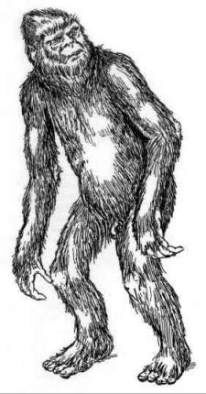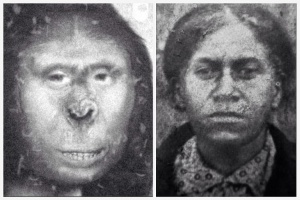(Other hominoid) Almas
The Almas, Mongolian for 'wild man', is a species of presumed hominid reputed to inhabit the Caucasus and Pamir Mountains of central Asia, and the Altai Mountains of southern Mongolia.
Contents
- Description
- Evidence
- Folk tales
- Famous sightings
- Captives
- Explanations
- References
Description
Almas is a singular word in Mongolian. As is typical of the unknown hominids throughout central Asia, Russia, and the Caucasus, Almas are generally considered to be more akin to "wild people" in appearance and habits than to apes (in contrast to the Yeti of the Himalayas or the Sasquatch of North America).
Almas are typically described as human-like bipedal animals, between five and six and a half feet tall, their bodies covered with reddish-brown hair, with anthropomorphic facial features including a pronounced browridge, flat nose, and a weak chin. They are usually described as unclothed, but a handful of sightings refer to primitive clothing. Many cryptozoologist researchers have been struck by the similarity between these descriptions and modern reconstructions of how Neanderthals might have appeared.
Evidence
There is speculation that Almas may be something other than legendary creatures, mainly via eyewitness accounts, footprint finds, and long-standing native traditions, which have been anthropologically, ethnographically, and cryptozoologically collected. Source: The Field Guide to Bigfoot and Other Mystery Primates by Loren Coleman and Patrick Huyghe (NY: HarperCollins, 1999, ISBN 1-933665-12-2).
Folk tales
Almas appear in the legend of local people, who tell stories of sightings and human-Almas interactions dating back several hundred years. Some of these accounts describe primitive communication between Almas and humans via the use of hand gestures and exchange of goods.
Drawings of Almas also appear in a Tibetan medicinal book. British anthropologist Myra Shackley noted that "The book contains thousands of illustrations of various classes of animals (reptiles, mammals and amphibia), but not one single mythological animal such as are known from similar medieval European books. All the creatures are living and observable today." (1983, p. 98)
Famous sightings
Sightings recorded in writing go back as far back as the 15th century.
In 1430, Hans Schildtberger recorded his personal observation of these creatures in the journal of his trip to Mongolia as a prisoner of the Mongol Khan. Schildtberger also recorded one of the first European sightings of Przewalski horses. (Manuscript in the Munich Municipal Library, Sign. 1603, Bl. 210).
Nikolai Przhevalsky observed the animals in Mongolia in 1871 (Shackley, 94). He noted that Almas are part of the Mongolian and Tibetan apothecary's materia medica]], along with thousands of other animals and plants that still live today.
British anthropologist Myra Shackley in Still Living? describes Ivan Ivlov's 1963 observation of a whole family of Almas. Ivlov, a pediatrician, decided to interview some of the Mongolian children who were his patients, and discovered that many of them had also seen Almas. It seems that neither the Mongol children nor the young Almas were afraid of each other. Ivlov's driver also claimed to have seen them (Shackley, 91).
Captives
A wildwoman named Zana is said to have lived in the isolated mountain village of T'khina fifty miles from Sukhumi in Abkhazia in the Caucasus; some have speculated she may have been an Almas, but hard evidence is lacking.
Captured in the mountains in 1850, she was at first violent towards her captors but soon became domesticated and, indeed, was able to assist with simple household chores. Zana is said to have had sexual relations with a man of the village named Edgi Genaba, and gave birth to a number of children of apparently normal human appearance. Several of these children, however, died in infancy. Some commentators have attributed these early deaths to Zana's genetic incompatibility (as an Almas) with humans.
The father, meanwhile, gave away four of the surviving children to local families. The two boys, Dzhanda and Khwit Sabekia (born 1878 and 1884), and the two girls, Kodzhanar and Gamasa Sabekia (born 1880 and 1882), were assimilated into normal society, married, and had families of their own. Zana herself died in 1890. The skull of Khwit (also spelled Kvit) is still extant, and was examined by Dr. Grover Krantz in the early 1990s. He pronounced it to be entirely modern, with no Neandertal features at all. If Krantz's verdict on the skull is correct, and the skull itself is indeed that of Zana's son, it would indicate that Zana may have been a member of an isolated hunter gatherer tribe so culturally different from her captors' society as to make Zana seem non-human to them, even though she was indeed a modern human. How this may relate to the true identity of other reported Almases is unknown.
Another case is said to date from around 1941, shortly after the German invasion of the USSR. A "wild man" was captured somewhere in the Caucasus by a detachment of the Red Army. He appeared human, but was covered in fine, dark hair. Interrogation revealed his apparent inability (or unwillingness) to speak, and the unfortunate creature is said to have been shot as a German spy. There are various versions of this legend in the cryptozoological literature, and, as with other Almas reports, hard proof is absent.
Explanations
Myra Shackley and Bernard Heuvelmans have speculated that the Almas are a relict population of Neanderthals, while Loren Coleman suggests surviving specimens of Homo erectus. Others insist they are related to the Yeti of the Himalayas, being closer to apes than to humans. The locals, for their part, often see no appreciable difference between Almas and humans, regarding them simply as "wild men" who remain untouched by civilization. Another explanation is that human-like cryptids are humans with congenital disorders and/or mental retardation and ejected from society.
Another explanation is that they are purely mythological creatures, since no hard evidence (skeletons, specimens, etc.) has been found to date.
References
- Hans Schildtberger's manuscript, Munich municipal library, Sign. 1603, Bl. 210
- Myra Shackley (1983), Still Living? ISBN 0-500-01298-9



